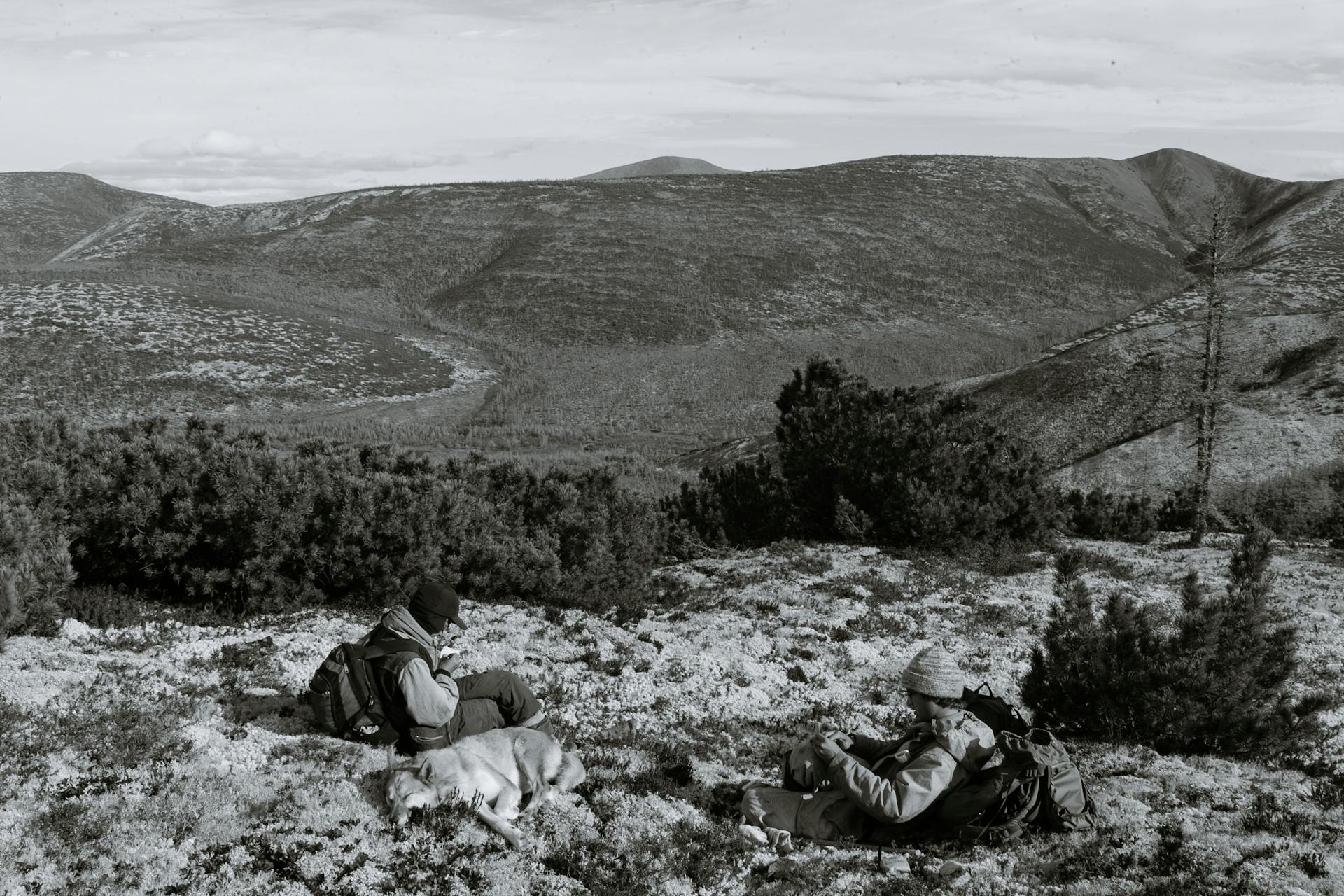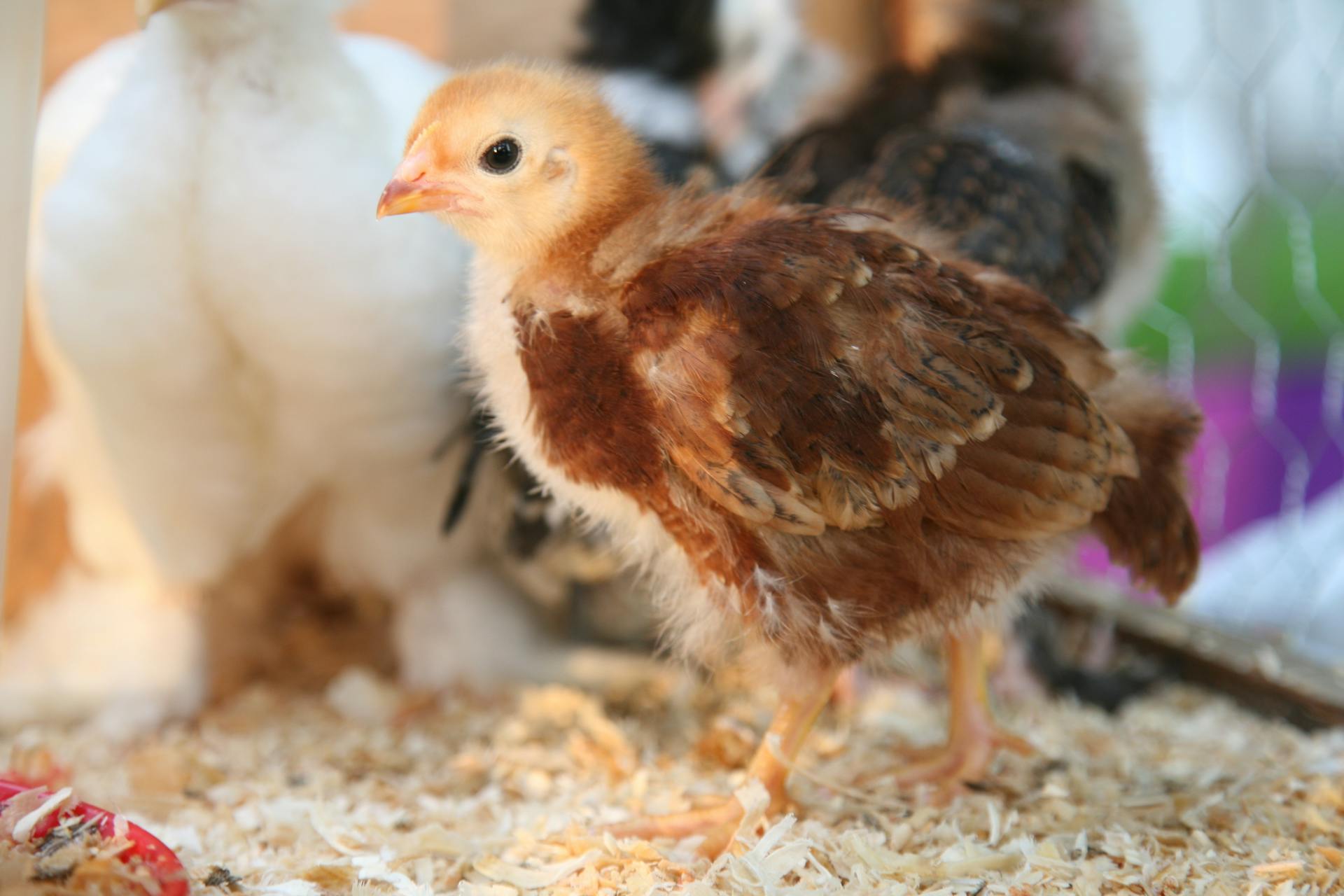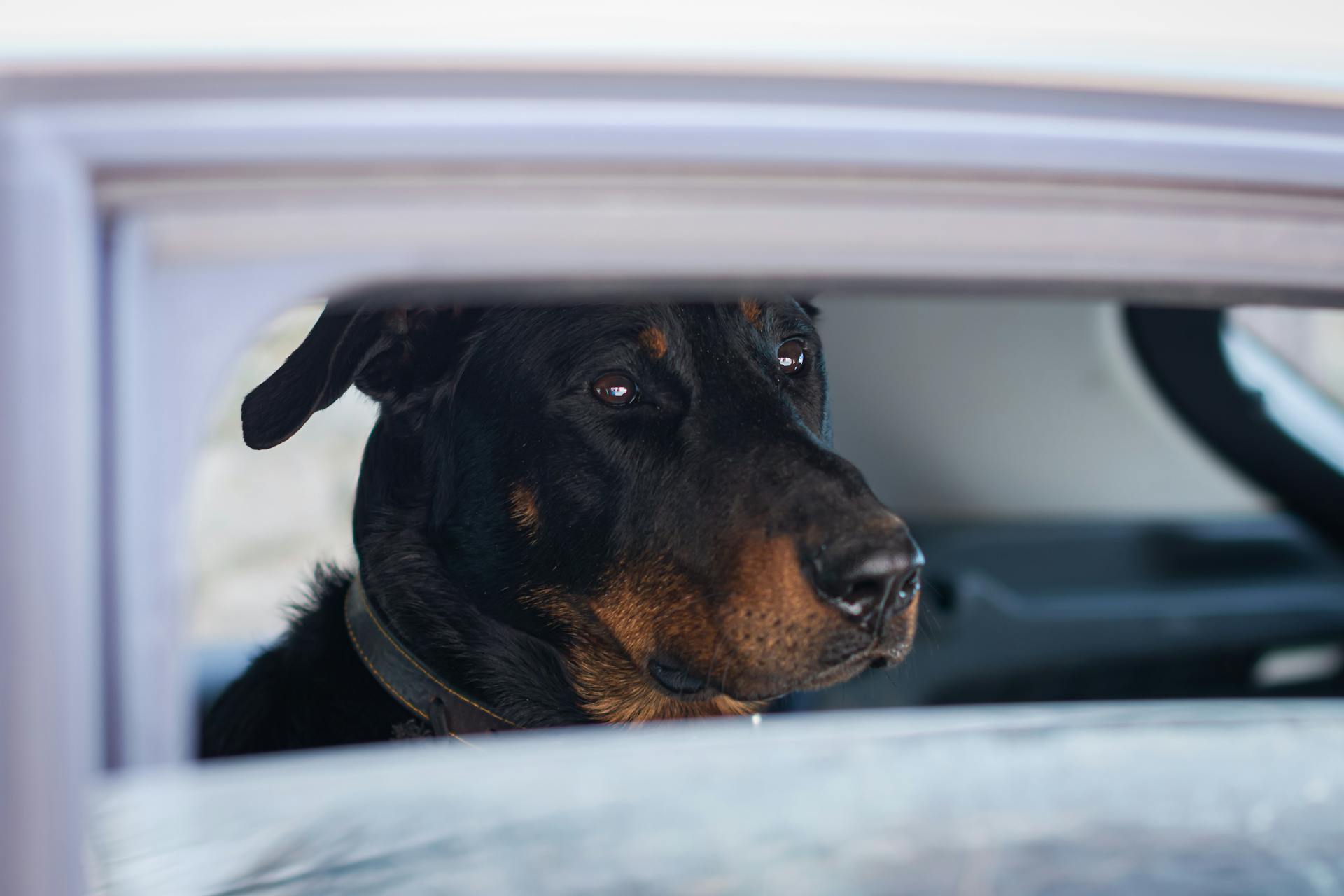
The Beauceron breed has a rich history that spans over 600 years, originating in France as a herding dog.
Developed in the 14th century, the Beauceron was bred to herd sheep and other livestock.
The breed's name "Beauceron" is derived from the region of Beauce in France, where the dogs were first developed.
The Beauceron was originally known as the Berger de Beauce, which translates to "shepherd of Beauce."
Related reading: Dog Breed Kuvasz
Physical Characteristics
The Beauceron's physical characteristics are truly impressive. They have powerful bodies with strong, straight backs and well-defined withers.
Their broad, short, muscular loins and wide, deep chests give them a sturdy build that's perfect for their herding and protective roles. Their tails are strong at the base and carried down, forming a slight "J" shape.
Beaucerons have high-set ears that may be cropped or natural, and their eyes are horizontal, slightly oval in shape, and dark brown. Walleye is acceptable in harlequin-colored dogs, but the overall expression is frank, alert, and confident.
Distinctive Physical Traits
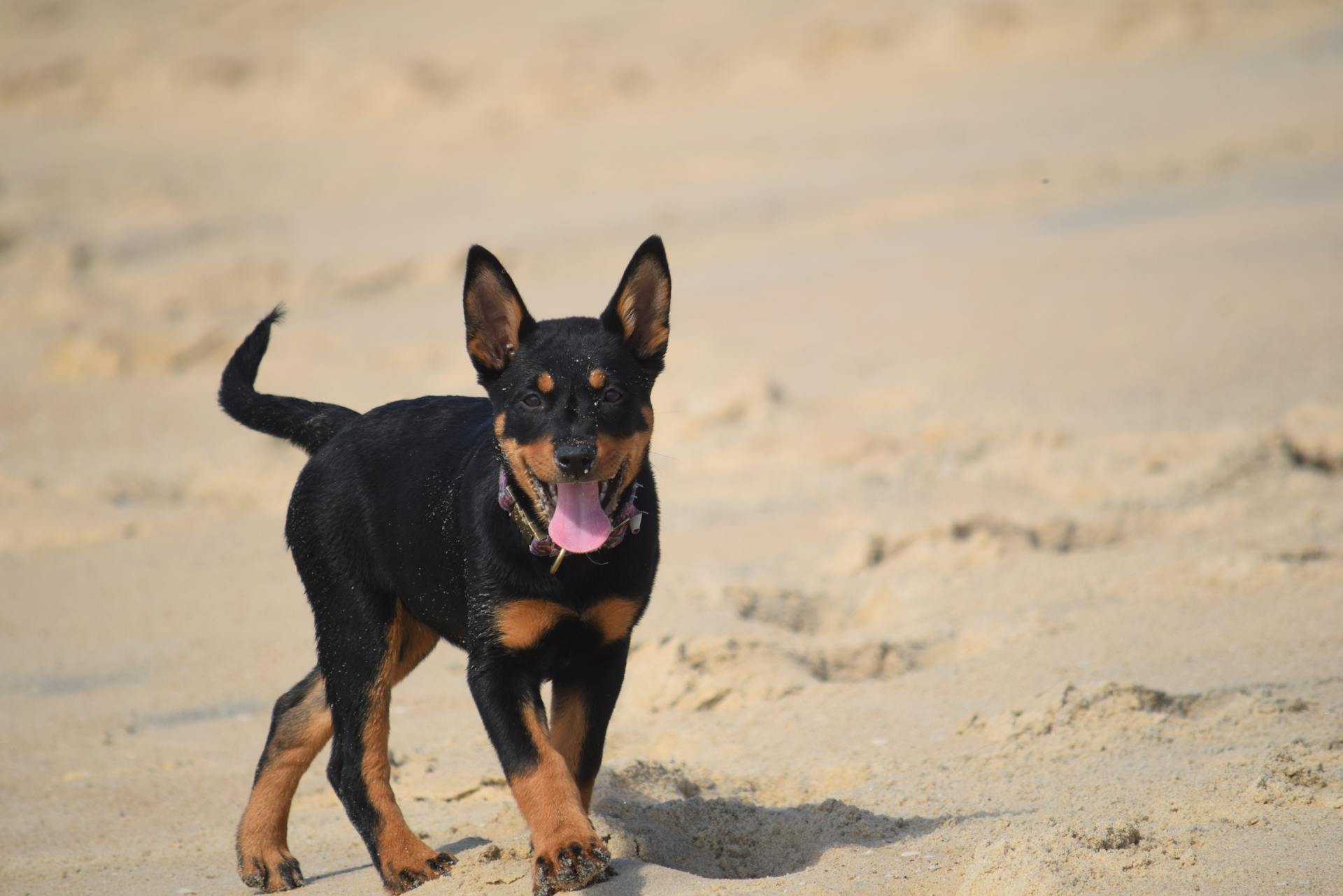
Beaucerons are powerful dogs with strong, straight backs; well-defined withers; broad, short, muscular loins; and wide, deep chests.
Their tails are strong at the base and carried down, descending to the point of the hock and forming a slight "J" but never falling to the right or left.
Beaucerons have high-set ears that may be cropped or natural, and eyes that are horizontal, slightly oval in shape, and dark brown (walleye is acceptable in harlequin-colored dogs).
The expression of a Beauceron is frank, alert, and confident, giving them a fearless and wolf-like appearance that demands respect through stoic confidence.
The breed's overall appearance showcases both power and agility, hallmarks of their herding and protective roles.
Beaucerons present themselves with a well-proportioned physique, with a length of body that is slightly greater than the height at the withers, giving them a slightly rectangular shape.
Their solid bone structure is a testament to their herding and protective roles, without appearing coarse or heavy.
Coat Characteristics
The Beauceron's coat is a key aspect of their physical characteristics. It's short and dense, making it well-suited for outdoor work.
The double-coated nature of the Beauceron's coat provides excellent protection against the elements. This is thanks to a fine, soft undercoat covered by a rough, straight outer coat.
The Beauceron comes in a variety of standard colors, including Black & Tan, Gray Black & Tan, Black & Rust, and Harlequin. Each of these colors has a corresponding genetic code, denoted by 'ee'.
Here's an interesting read: Black and Tan English Shepherd
Personality
The Beauceron's personality is a beautiful blend of intelligence, loyalty, and courage, deeply rooted in its herding lineage.
This breed is known for being confident and self-assured, but never mean. They're loyal, affectionate, and gentle with their families, making them excellent companions.
Beaucerons tend to prefer wide open spaces to big cities, where they can run freely and exercise their high energy levels.
Their innate protective instincts make them excellent watchdogs that will warn off intruders with their bark before going back to cuddling with their owners.
Beaucerons are highly-spirited dogs that require consistent and patient training, especially for novice dog owners. They're eager to please, but their strong-willed nature calls for clear guidance.
Their underlying sensitivity might escape the casual observer's notice, so it's essential to provide positive reinforcement and avoid harsh treatment.
Socialization is key for this breed, as they have an inherent need to be with their "pack" and can become bored or destructive if left alone for long periods.
A well-trained and socialized Beauceron can coexist harmoniously with other dogs, but their herding tendencies might sometimes prompt them to "herd" other household pets.
Their assertive nature could manifest in dominant behavior, particularly towards dogs of the same gender, so it's crucial to introduce them to other dogs at a young age.
Families with children can find a gentle giant in the Beauceron, which is typically protective and kind when raised alongside kids.
Training and Herding
Beaucerons are intelligent dogs that thrive on training, and they need guidance to channel their boundless energy. They're quick to pick up new tasks, but they don't respond well to punitive training methods.
To train a Beauceron, you need to be firm, fair, and consistent. Harsh physical corrections can be detrimental to their development. Beaucerons are highly intelligent breeds that respond well to positive reinforcement and clear guidance.
As a herding breed, Beaucerons were developed to guard and control the movement of livestock.
Training
Beaucerons are intelligent dogs that thrive on training. They're quick to pick up new tasks, but they need guidance to channel their boundless energy.
Be firm, fair, and consistent when training a Beauceron. Harsh physical corrections can be counterproductive and even harmful.
Redirecting their tendency to jump or be mouthy in play requires patience and positive reinforcement. With the right approach, they can learn to channel their energy in a positive way.
Consistency is key when training a Beauceron. They respond well to routine and clear expectations.
Herding
Herding is a diverse category that includes highly intelligent breeds developed to guard and control the movement of livestock.
These breeds were created to manage and protect large groups of animals, requiring them to be highly responsive to commands and able to think on their feet.
Their intelligence and trainability make them well-suited for a variety of roles, from farm work to search and rescue operations.
In order to succeed in herding, these breeds need to be able to read the body language and behavior of both the animals they're working with and the people giving them commands.
General Information
The Beauceron is an ancient breed with a rich history. They originated in France, specifically in the Beauce region, from which they get their name.
Their exact age is unknown, but they're believed to have been around since the Middle Ages. They were originally bred to herd livestock and guard property.
The Beauceron is a medium to large-sized dog with a muscular build. Males typically weigh between 80-110 pounds and stand 24-27 inches tall at the shoulder.
Their distinctive coat is made up of two layers: a soft undercoat and a harsh outer coat. They come in three main colors: black, blue, and tan.
History and Origins
The Beauceron breed originated in France, specifically in the Beauce region near Paris, where it was used for herding and guarding livestock.
The breed has a documented history dating back to the 1500s, with early illustrations and descriptions of a Beauceron-like dog present in Renaissance manuscripts.
The first breed club, the Club des Amis Du Beauceron, was not founded until 1922, although the breed was already well established in France by then.
The Beauceron was employed as a military dog during World Wars I and II, serving as a messenger, tracker, and mine detector.
Its intelligence, loyalty, and physical prowess made it an invaluable asset in these roles, and the breed's popularity as a family companion, protector, and competitor in dog sports has risen over the years.
The breed's first official Breed Standard was established in 1897, and it was fully inducted into the American Kennel Club's Herding Group in 2007.
Explore further: When Did Labradoodles Originate
History
The Beauceron breed has a rich history that spans several centuries. It originated in France, specifically in the Beauce region near Paris.
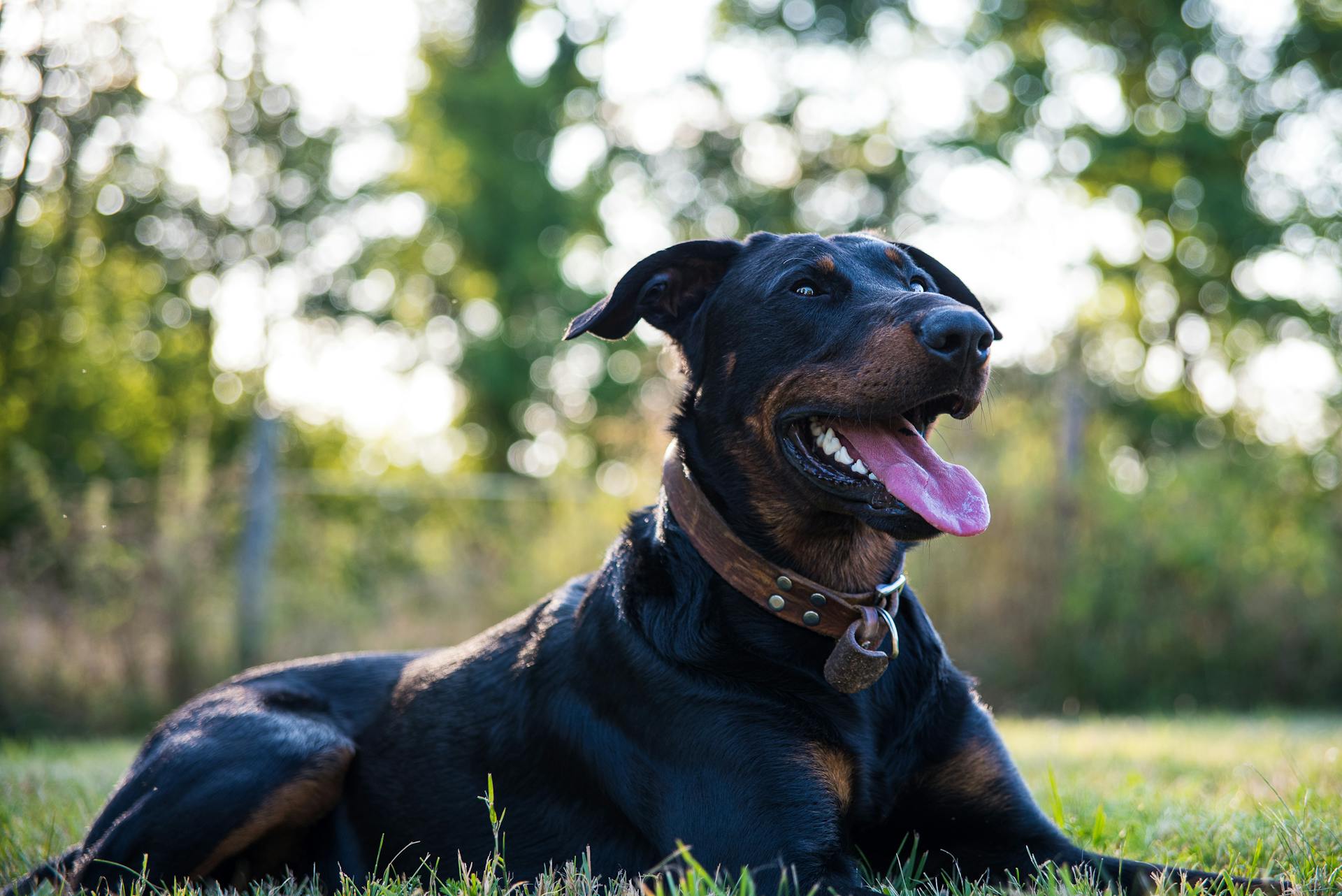
The breed was first mentioned in the 1500s, with early illustrations and descriptions of a Beauceron-like dog present in Renaissance manuscripts. This suggests that the breed has a long and storied past.
The Beauceron was used as a working dog, valued for its herding capabilities and protective instincts. Its primary responsibility was to aid French shepherds and farmers in herding and guarding large flocks of sheep.
The breed's documented history can be traced back to the late 16th century, with the first French dog show featuring the Beauceron in 1863. This marked the beginning of efforts to categorize and standardize the breed.
The Beauceron played significant roles during both World Wars, with its intelligence, trainability, and loyalty harnessed for tasks such as carrying messages, detecting mines, and supporting troops.
You might like: What Was French Bulldogs Bred for
History and Origins
The Beauceron breed has a rich history that dates back to France. They originated in the Beauce region of France, where they were bred to herd livestock.
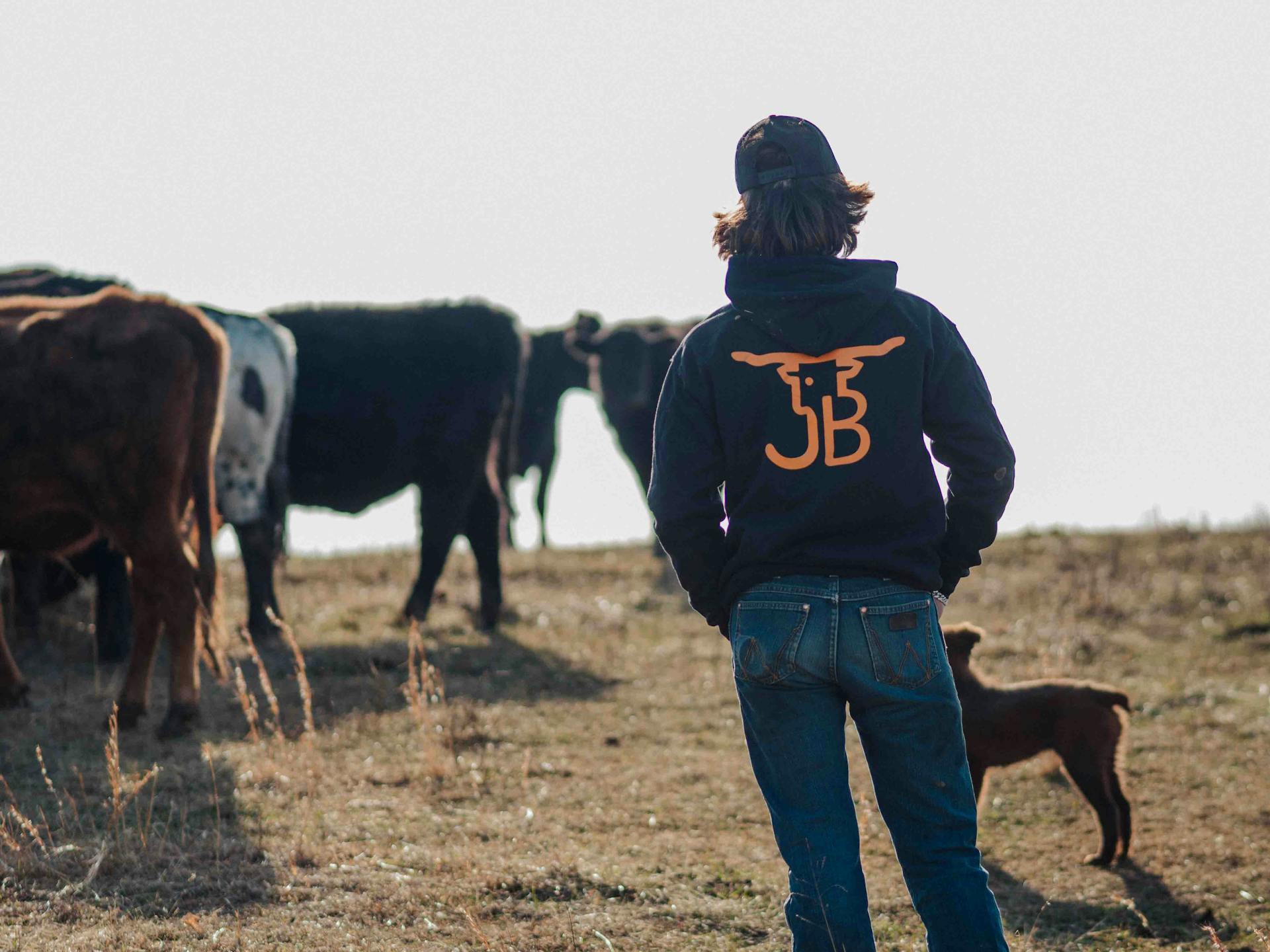
The Beauceron's origins are closely tied to its herding instincts, which were honed over centuries. This breed was developed to work in the fields and pastures of rural France.
One of the key characteristics of the Beauceron is its intelligence, which was essential for its original purpose as a herding dog. This breed was known for its ability to think on its feet and make quick decisions.
The Beauceron's calm and protective nature also made it an ideal breed for guarding livestock. Its fearless attitude allowed it to stand up to predators and protect its flock.
Here's a breakdown of the Beauceron's group classification and recognition worldwide:
The Beauceron's origins in France are a testament to its unique characteristics and abilities.
Frequently Asked Questions
What is the closest relative to the Beauceron?
The Beauceron's closest relative is the Briard, a breed it was previously considered to be part of. This similarity was only officially recognized in 1893 by veterinarian Paul Megnin.
Featured Images: pexels.com
